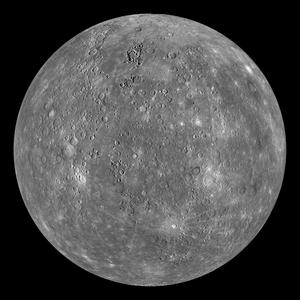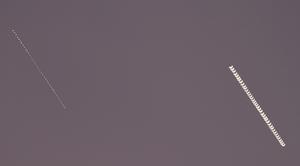Glossary term: Mercure
Description: Mercure est la planète la plus proche du Soleil et la plus petite des huit planètes principales du système solaire. Il s'agit d'une planète terrestre rocheuse d'un rayon d'environ 2 500 kilomètres (km), soit un peu plus que la Lune. Sa masse est 0,055 fois supérieure à celle de la Terre. En raison de sa faible distance, le Soleil est sept fois plus brillant vu de Mercure par rapport à la Terre, et la surface de Mercure est très affectée par le vent solaire. Son exosphère, très fine, est constituée de matériaux produits par cette interaction, ainsi que de matériaux arrachés à la surface en raison de la chute fréquente d'objets. La fine atmosphère ne peut pas maintenir la température de la planète, de sorte que la surface est extrêmement froide (-180 degrés Celsius) pendant la nuit et extrêmement chaude (400 degrés Celsius) pendant la journée, et donc très sèche.
Sa distance moyenne par rapport au Soleil est d'environ 58 millions de km, soit environ 0,39 unité astronomique (distance Terre-Soleil), et il lui faut un peu moins de 88 jours pour parcourir une orbite. Mercure n'a pas de lunes connues autour d'elle.
Comme Mercure orbite autour du Soleil plus près que la Terre, elle apparaît toujours près du Soleil dans le ciel. Mercure porte le nom du dieu messager romain, en raison de son déplacement rapide dans le ciel. Deux sondes spatiales (Mariner 10 et MESSENGER) ont visité Mercure, et la mission BepiColombo devrait arriver en décembre 2025.
Related Terms:
See this term in other languages
Term and definition status: The original definition of this term in English have been approved by a research astronomer and a teacher The translation of this term and its definition is still awaiting approval
The OAE Multilingual Glossary is a project of the IAU Office of Astronomy for Education (OAE) in collaboration with the IAU Office of Astronomy Outreach (OAO). The terms and definitions were chosen, written and reviewed by a collective effort from the OAE, the OAE Centers and Nodes, the OAE National Astronomy Education Coordinators (NAECs) and other volunteers. You can find a full list of credits here. All glossary terms and their definitions are released under a Creative Commons CC BY-4.0 license and should be credited to "IAU OAE".
If you notice a factual or translation error in this glossary term or definition then please get in touch.
Related Media
Mercure
Credit: NASA/Johns Hopkins University Applied Physics Laboratory/Carnegie Institution of Washington credit link
License: PD Public Domain icons
Moon-Mercury-Pleiades Conjunction
Credit: Giulio Colombo/ IAU OAE
License: CC-BY-4.0 Creative Commons Attribution 4.0 International (CC BY 4.0) icons
Venus and Mercury Trails
Credit: Marcella Giulia Pace (CC BY 4.0)
License: CC-BY-4.0 Creative Commons Attribution 4.0 International (CC BY 4.0) icons











